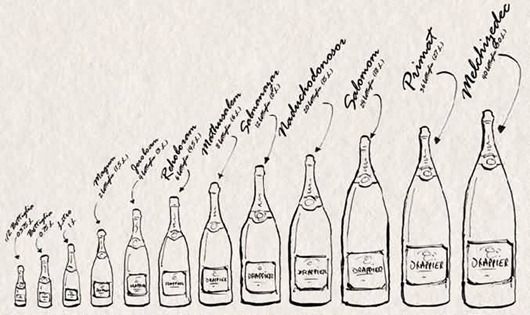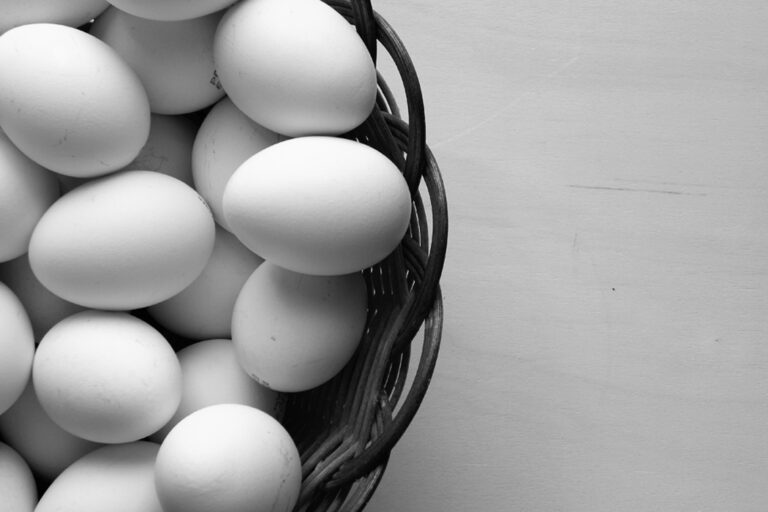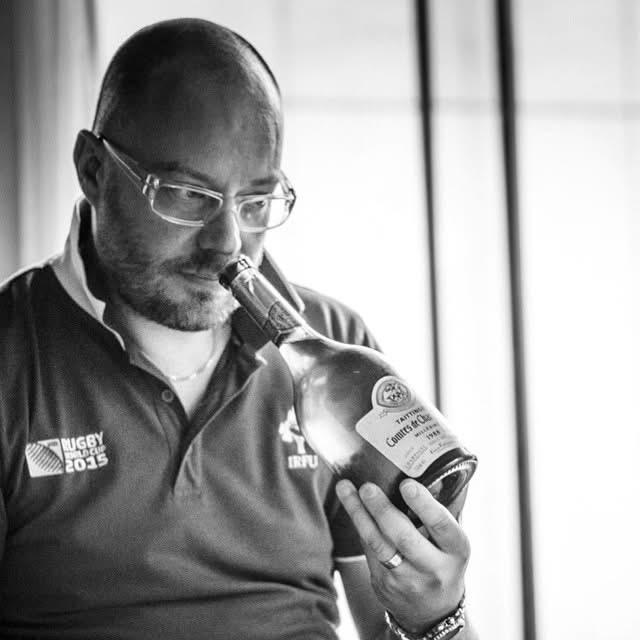Champagne is a prestigious sparkling wine that comes uniquely from the Champagne region in France, governed by stringent French AOC (Appellation d’Origine Contrôlée) regulations. This classification ensures that only sparkling wine produced within this area, under specific production methods, can be rightfully called Champagne. [read the full champagne story]
Estimated reading time: 10 minutes

Champagne Fundamentals
Bottle Sizes and Variations:
A standard champagne bottle contains 750 milliliters of this effervescent drink. However, you’ll find a diverse range of bottle sizes, each with its own name:
| Size | Volume | Equivalent Bottles |
|---|---|---|
| Standard | 750 ml | 1 |
| Magnum | 1.5 L | 2 |
| Jeroboam | 3 L | 4 |
| Rehoboam | 4.5 L | 6 |
| Methuselah | 6 L | 8 |
| Salmanazar | 9 L | 12 |
| Balthazar | 12 L | 16 |
| Nebuchadnezzar | 15 L | 20 |
Primary Grape Varieties:
Your champagne may showcase a single grape or a blend typically comprising Chardonnay, Pinot Noir, and Pinot Meunier. Each contributes its own characteristics to the complexity of the champagne’s flavor profile.
Method of Production:
The ‘Traditional Method’ of secondary fermentation in the bottle is essential to champagne production, contributing to its distinct bubbly quality. The wine undergoes a process including fermentation, blending, bottling with a sugar and yeast mixture, aging, riddling, and disgorgement, which creates its signature taste and effervescence.
Labeling Terms to Know:
- “Vintage” indicates that all grapes used were harvested in the same year.
- “Non-Vintage” (NV) shows a blend of harvests to achieve a consistent house style.
- “Blanc de Blancs” is made exclusively from white grapes, typically Chardonnay.
- “Blanc de Noirs” refers to white champagne made from dark-skinned grapes.
Champagne Bottle Types
Champagne is traditionally bottled in varying sizes, and each type plays a unique role in storage, aging, and serving. Understanding these types can enhance your selection for events and celebrations.
Standard Bottle
- Size: 750 ml
- Servings: Approximately 6 glasses
The Standard Bottle is the most common and is ideal for small gatherings. It holds about 6 glasses of champagne, making it perfect for an intimate celebration.
Piccolo and Splits
- Size: 187.5 ml for Piccolo, 200 ml for Split
- Servings: About 1 glass
Piccolo and Splits are mini champagne bottles often served at large events for single servings or as part of a celebration where individual presentations are desired.
Demi and Quarter
- Size: 375 ml
- Servings: Approximately 3 glasses
A Demi or Quarter Bottle is half the size of a standard bottle and is suitable when you’re enjoying champagne for two.
Magnum
- Size: 1.5 liters
- Servings: 12 glasses
The Magnum is equivalent to two standard bottles and is preferred for its optimal aging potential and at gatherings for its impressive presence.
Jeroboam
- Size: 3 liters
- Servings: 24 glasses
The Jeroboam Champagne Bottle holds the same as four standard bottles. This size is a favorite for significant occasions and ensures a festive atmosphere.
Rehoboam
- Size: 4.5 liters
- Servings: 36 glasses
With six times the volume of a standard bottle, a Rehoboam is often the centerpiece at large parties.
Methuselah
- Size: 6 liters
- Servings: 48 glasses
An impressive sight at any celebration, the Methuselah Champagne Bottle contains eight standard bottles’ worth of champagne.
Salmanazar
- Size: 9 liters
- Servings: 72 glasses
A Salmanazar Champagne Bottle serves a substantial crowd with its capacity equal to 12 standard bottles.
Balthazar
- Size: 12 liters
- Servings: 96 glasses
The Balthazar is a showstopper, providing 16 standard bottles of champagne, ideal for grand-scale events.
Nebuchadnezzar
- Size: 15 liters
- Servings: 120 glasses
The Nebuchadnezzar Champagne Bottle is a colossal container for champagne, perfect for major celebrations needing ample servings.
Solomon
- Size: 18 liters
- Servings: 144 glasses
Rare and remarkable, the Solomon Champagne Bottle is equivalent to 24 standard bottles, used for the most lavish events.
Primat
- Size: 27 liters
- Servings: 216 glasses
At 36 times the volume of a standard bottle, the Primat Champagne Bottle is often at the center of a large, prestigious celebration.
Melchizedek
- Size: 30 liters
- Servings: 240 glasses
The Melchizedek Champagne Bottle is the largest size commonly available, suitable for the grandest occasions, with a capacity equal to 40 standard bottles.
Champagne Production Process
The process of producing Champagne is intricate and precise, requiring adherence to strict guidelines outlined within the Champagne appellation. Starting with the selection of grapes, typically Chardonnay, Pinot Noir, and Pinot Meunier, they are harvested from the Champagne region of France to ensure authenticity.
Primary Fermentation: Your grapes are pressed and the juice is subjected to the first fermentation. This initial phase converts natural sugars into alcohol, resulting in a still wine base.
Blending: You may blend wines from different harvests to achieve a desired flavor profile; this is known as the assemblage.
Secondary Fermentation: The hallmark of Champagne production occurs during the second fermentation. You add a mixture of sugar and yeast, known as the liqueur de tirage, to the still wine in the bottle, inducing a second fermentation that produces carbon dioxide and gives Champagne its effervescence.
Aging on Lees: After bottling, your Champagne must age on the lees, the dead yeast cells, for a minimum of 15 months for non-vintage and three years for vintage labels. This aging process contributes complex flavors and creamy textures to the Champagne.
Riddling: To collect the lees in the neck of the bottle, riddling is performed, traditionally by hand, but now often mechanically. The bottle is gradually tilted and turned to encourage the lees to settle near the cork.
| Step | Description |
|---|---|
| Disgorging | The collected lees is removed in a process called disgorging while preserving the Champagne’s carbonation. |
| Dosage | A mixture of wine and sugar syrup, the dosage is added to adjust sweetness levels post-disgorgement. |
| Final Corking | Champagne corks, which are larger and specially designed to withstand pressure, are then inserted. |
After final corking, the bottle is sealed with a wire cage to ensure the cork remains fixed despite the internal pressure. Labels are applied, and the Champagne is ready for further aging or distribution.
Champagne Serving and Storage
When serving Champagne, temperature is crucial. Aim for a serving temperature between 8°C and 10°C (46°F-50°F). To achieve this, place your bottle in the refrigerator at least 3-4 hours before serving, or 30 minutes in an ice bucket with half ice, half water.
Here’s a guideline for chilling times based on bottle sizes:
| Bottle Size | Chilling Time in Refrigerator |
|---|---|
| Standard (750 ml) | 3-4 hours |
| Magnum (1.5 L) | 5-6 hours |
| Jeroboam (3 L) | More than 6 hours |
Tilt the glass and pour Champagne slowly to preserve its bubbles. It’s important not to fill the glass; a half or two-thirds is optimal to allow the bouquet to develop and the aromas to be released.
Storage of Champagne should be in a cool, dark place, away from vibrations and with a consistent temperature, ideally between 10°C and 15°C (50°F-59°F). If you’re storing multiple bottles, keep them on their side to keep the cork moist and maintain the seal.
Avoid storing your Champagne in a standard refrigerator for long periods; beyond a few days, the lack of moisture can dry out the cork, potentially allowing air into the bottle and spoiling the Champagne. If you’ve opened a bottle and want to save it for later, a Champagne stopper can help maintain its effervescence for up to 48 hours. Remember, the larger the bottle, the longer the Champagne will keep its sparkle after being opened, due to a lower surface-to-air ratio.
Cultural and Historical Significance
Champagne, a symbol of celebration and luxury, has roots deeply entwined with historical and cultural milestones. Biblical kings and figures, such as King David, have been linked to the significance of wine in ceremonies, though Champagne as you know it was not yet created during these ancient times. Yet, the evolution of Champagne parallels the aspiration to craft superior wines that were once prized in the Northern Kingdom of Israel.
The transformation of Champagne into a sparkling wine is attributed to the 17th-century Benedictine monk Dom Pérignon. His contributions to the champagne-making process marked a significant turning point that shaped how you perceive and consume Champagne today. His legacy is marked by the pursuit of excellence and innovation in winemaking.
In the Western world, Champagne quickly became associated with affluence and festivity. Monarchs and aristocrats celebrated their victories and alliances with this effervescent wine. The tradition of toasting with Champagne spread far and wide, becoming a staple at major events like ship launchings, weddings, and New Year’s celebrations.
| Time Period | Cultural Significance |
|---|---|
| 17th Century | Innovation by Dom Pérignon |
| 18th Century | Aristocratic symbol of wealth and celebration |
| 19th Century | Expansion to middle-class festivities |
Your understanding of Champagne’s cultural and historical significance is enhanced by recognizing its journey from royal courts to becoming a global ambassador of merriment. Champagne has transitioned from a drink for the privileged few to an integral part of contemporary celebrations across various cultures.
Purchasing and Gifting Champagne
When you decide to purchase champagne, whether for personal enjoyment or as a gift, consider the occasion and the recipient’s preferences. Gift hampers containing a regular champagne bottle often come with an array of complementary items such as glasses, gourmet chocolates, or artisanal cheeses, making them a thoughtful and convenient gift.
For airline travel, it is crucial to note that you can typically only bring champagne in checked luggage due to liquid restrictions on airplane flights. Choose a bottle size that complies with the airline’s weight limitations.
| Bottle Size | Ideal Occasion |
|---|---|
| Standard (750ml) | Dinner parties or as a personal gift |
| Mini (187ml) | Party favors or in-flight gifting |
Use the following guidelines when selecting champagne:
- Price vs. Quality: Not all expensive champagnes are superior, and many reasonably priced bottles offer excellent quality. Research and read reviews to make informed decisions.
- Presentation: To enhance your gift’s impact, opt for champagnes with an elegant label design or a distinctive bottle shape.
- Personalization: Adding a personalized message or a custom label can significantly elevate the perceived value of your gift.
When purchasing champagne, check for any promotions or discounts, as retailers often have special offers, particularly during the holiday season. Remember, when you gift champagne, you are not just giving a bottle but also the celebration and sophistication it represents. Ensure you adhere to any regional alcohol purchasing regulations.
Frequently Asked Questions
In this section, you’ll find precise answers to some of the most common queries regarding the various champagne bottle sizes, their impact on the aging process, dimensions, and the roles larger bottles play in celebrations.
What are the various sizes of champagne bottles and their respective names?
Champagne bottles range from the miniature Quarter (0.2 liters) to the monumental Melchizedek (30 liters). Each size has a unique name, often biblical, such as Magnum (1.5 liters), Jeroboam (3 liters), Rehoboam (4.5 liters), Methuselah (6 liters), and more.
How does the size of a champagne bottle affect the aging process of champagne?
Larger bottles have a slower oxidation rate due to the smaller surface area of the cork in contact with the air. This can result in a potentially longer aging process, allowing for more complex flavor development during maturation.
What are the dimensions of a standard champagne bottle in centimeters and millimeters?
A standard champagne bottle, known as a bottle, typically measures about 30 centimeters (300 millimeters) in height with a diameter of approximately 8.89 centimeters (88.9 millimeters) at the base.
Can you explain the significance of larger champagne bottles, such as Nebuchadnezzar and Melchizedek?
Larger champagne bottles like the Nebuchadnezzar (15 liters) and Melchizedek (30 liters) are impressive showpieces at events, believed to present a better aging potential for champagne due to their volume and the reduced oxidation through the cork.
What is the name given to a champagne bottle containing 12 bottles’ volume?
A champagne bottle that holds the volume of 12 standard bottles is called a Balthazar, which equates to 12 liters of champagne.
What are the advantages of using larger champagne bottles for events and celebrations?
Using larger champagne bottles at events not only provides a wow factor due to their size but also offers practical benefits such as a consistent quality of champagne, since it originates from a single batch, and improved aging characteristics for a better tasting experience.





